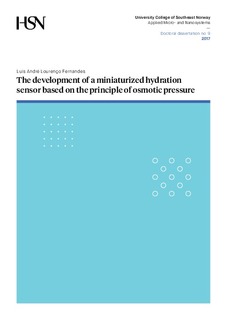| dc.contributor.author | Fernandes, Louis André Lourenço | |
| dc.date.accessioned | 2017-02-14T09:42:22Z | |
| dc.date.available | 2017-02-14T09:42:22Z | |
| dc.date.issued | 2017 | |
| dc.identifier.isbn | 978-82-7860-287-4 | |
| dc.identifier.issn | 2464-2843 | |
| dc.identifier.uri | http://hdl.handle.net/11250/2430680 | |
| dc.description.abstract | The thesis presents a novel hydration sensor that employs osmotic pressure to detectde‐ and overhydration in body fluids. This sensor could be used to measure different levels of hydration in an organism, e.g. the human body. A prototype was fabricated in an acetal copolymer integrating a semi‐permeable membrane and an electronic interface containing a resistive pressure transducer together with an ASIC and a few discrete components assembled on a silicon substrate. The sensor has a cavity (reference chamber) with a pressure transducer used to record the osmotic pressure induced by the physical separation between two solutions of different salt concentrations: the reference solution (inside the sensor’s cavity) and the external media. The hydration sensor described in this work offers an alternate solution to the methods used today for measuring hydration (sampling of body fluids, skin impedance analysis, body weight, etc.). This makes it less complex, portable, smaller in size, with a low power consumption and capable of continuous measurements. Its low power architecture, in combination with the advances made in microfabrication, make it a suitable candidate for further miniaturization and implantation in the human body. This technology is a versatile medical sensor because of the physical principles it implements, for example: It uses a semi‐permeable membrane for solute selectivity permitting the detection of changes in the concentration of different molecules in the human body which are indicators of changes in the human body electrochemical balance, helping to monitor different pathologies. Making use of the membrane’s physical (porous size and density), chemical and electrical properties one can monitor (through an osmotic process) different solutes/molecules from the extracellular fluids and use the osmotic hydration sensor to sense other parameters, such as diabetes (glucose), kidney function (Sodium concentration), and blood volume (Hemoglobin), where the last parameter described is particularly important for post‐operative care. The sensor presented in this work has three different development stages investigated with the use of other prototype sensors, which paved the way towards a final device, a proof of concept of a novel osmotic hydration sensor that is validated for measuring hydration “in vitro”. The osmotic hydration sensor encapsulation was manufactured in acetal copolymer integrating a 25.4 μm thick ion‐exchange Nafion (NR211) membrane and a silicon substrate measuring 10x10 mm. Both the pressure transducer and the ASIC were integrated to the substrate. The sensor was tested/validated for a ±20% hydration span, ranging from 220 mOsmL‐1 (overhydration) to 340 mOsmL‐1 (dehydration) and showing a resolution of approximately 2% with a response time of 5.5 hours to reach 100% signal. This result, corresponds to an accuracy of 5.71 bits for the sensor’s dynamic range. The low power architecture implemented in the ASIC uses a low voltage supply (1 V) in the sub‐threshold regime with bias currents of approximately 50 nA resulting in an average power consumption of only 39.4 μW. An Analog‐to‐Analog approach converts the voltage signal from the pressure transducer (due to a change in resistance) into a frequency output that, for every transition on the output, inverts the power to the transducer. This approach results in a resistance controlled oscillator (RCO), eliminatingthe use of a power‐consuming clock to drive an Analog to Digital converter (ADC). | nb_NO |
| dc.language.iso | eng | nb_NO |
| dc.publisher | University College of Southeast Norway | nb_NO |
| dc.relation.ispartofseries | Doctoral dissertations at the University College of Southeast Norway;9 | |
| dc.relation.haspart | I: L. A. Fernandes, P. Häfliger, M. Azadmehr, and E. Johannessen, "Design and characterization of an osmotic sensor for the detection of events associated with dehydration and overhydration," IEEE Journal of Translational Engineering in Health and Medicine, vol. 1, pp. 1‐9, 21 August 2013. | nb_NO |
| dc.relation.haspart | II: N. Trung Thanh, L. A. L. Fernandes, and P. Häfliger, "An Energy‐Efficient Implantable Transponder for Biomedical Piezo‐Resistance Pressure Sensors," Sensors Journal, IEEE, vol. 14, pp. 1836‐1843, 2014. | nb_NO |
| dc.relation.haspart | III: L. A. Fernandes, E. Johannessen, M. Azadmehr, and P. Häfliger, "Low power integrated electronics system for the operation of a miniaturized hydration sensor," presented at the IEEE International New Circuits and Systems (NEWCAS), Trois‐ Rivières, Canada, vol. 14, pp. 17‐20, 2014 (invited for communication/presentation). | nb_NO |
| dc.relation.haspart | IV: L. A. Fernandes, P. Häfliger, M. Azadmehr, and E. Johannessen, “An osmotic pressure sensor for monitoring the level of hydration in biological fluids”, Sensors Journal, IEEE, vol. 16, pp. 4331‐4337, 2016. | nb_NO |
| dc.rights | Attribution-NonCommercial-NoDerivatives 4.0 Internasjonal | * |
| dc.rights.uri | http://creativecommons.org/licenses/by-nc-nd/4.0/deed.no | * |
| dc.subject | Hydration sensor | nb_NO |
| dc.title | The development of a miniaturized hydration sensor based on the principle of osmotic pressure | nb_NO |
| dc.type | Doctoral thesis | nb_NO |
| dc.subject.nsi | VDP::Teknologi: 500::Medisinsk teknologi: 620 | nb_NO |
| dc.source.pagenumber | 144 | nb_NO |

